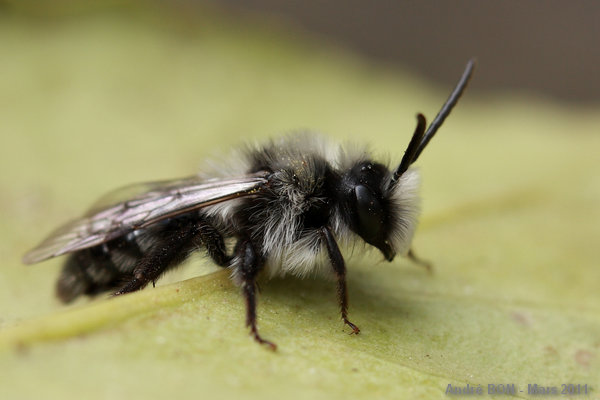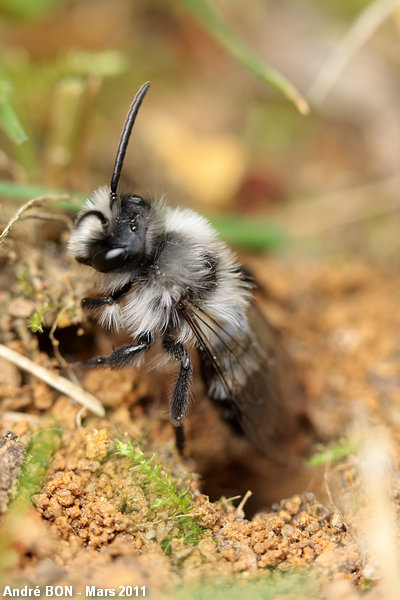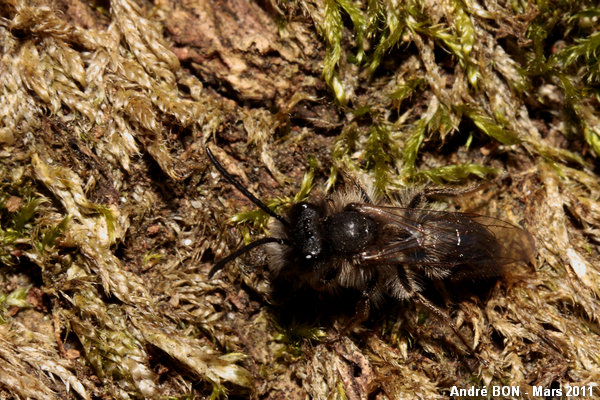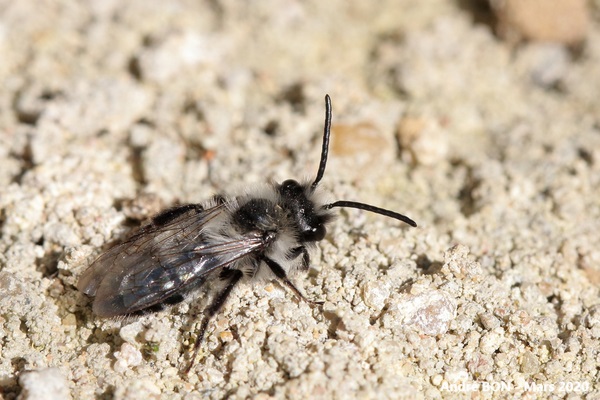





| Ashy Mining-bee (Andrena cineraria (Linnaeus, 1758)) |






|
|
Scientific name: Andrena cineraria (Linnaeus, 1758) Common name: Ashy Mining-bee French name: Order: Hymenoptera Family: Andrenidae Wingspan : 13 mm, males are slightly smaller than females. Biotope: Parks and gardens, orchards, calcareous meadows, edges of cultivated areas, sandy soils. Geographic area: Western and Central Europe, north to Scandinavia, present but scarcer in the Mediterranean region. Observation period : March to June-July. |
Andrena sp. are solitary bees which dig their nest in the ground as a single gallery which ramifies and leads to several cells. Trochanters and femora of the females' hind legs are covered with tufts of curved hairs which are used to collect pollen. The tongue is short. The fore wings show three submarginal cells. The basal vein, running in diagonal towards the pterostigma and coming from the inner side, is very slightly curved. Andrena cineraria is black with a strong white pilosity, on the front of head, on the sides of the thorax and on the first tergites. The upper side of the thorax is crossed by a band of black hairs. The upper side of the abdomen shows a blue sheen. There is a possible confusion with Andrena vaga whose thorax is normally uniformly covered with grey hairs, lacking the band of black hairs. Another way to be sure to correctly tell these species apart is to have a look at the third article of the antennae (starting at 1 for the scape). The third article is twice as long as the fourth on Andrena vaga. These articles are the same length on Andrena cineraria. Each nest burrow ramifies and leads to about ten cells where the female lay one egg and store pollen and nectar for the larva. Some parasite Cuckoo bee species lay they eggs inside the burrow when the Ashy Mining-bee is away. |
| [To know more about the Ashy Mining-bee] [Next picture] [Top] |

|
I have observed this Ashy Mining-bee in my garden. I have delicately lifted it up on the underside of a leaf. It stayed there during a few minutes so that I have been able to try my new macro lenses. |
| [To know more about the Ashy Mining-bee] [Next picture] [Previous picture] [Top] |

|
I have used the Live view mode to perfectly adjust the focus on the eye. The articles of the antennae are well visible on this picture. |
| [To know more about the Ashy Mining-bee] [Next picture] [Previous picture] [Top] |

|
Here is the Ashy Mining-bee walking out of its gallery. I have observed it here for the first time. |
| [To know more about the Ashy Mining-bee] [Next picture] [Previous picture] [Top] |

|
I have had some difficulties in identifying this Mining-bee species. I have asked the help of Alain Ramel and he told me that this one is a male Andrena cineraria. I have been able to confirm this species identification by zooming on the articles of the antenna (non reduced picture). I have noticed that the third and fourth articles are almost the same size. |
| [To know more about the Ashy Mining-bee] [Next picture] [Previous picture] [Top] |

|
I have read that you can recognize males by their long hairs on the front of the head. I have also read the contrary, telling that you can also observe this pilosity on females. So we will remain very careful regarding this criteria. I still need to make progress with the use of the flash light. |
| [To know more about the Ashy Mining-bee] [Previous picture] [Top] |

|
There are 13 articles on the antennae, it is a male. The antennae of females have only 12 articles. Females have also a tuft of white hairs only on front femora while males have tuft of white hairs on all femora like on this picture. |